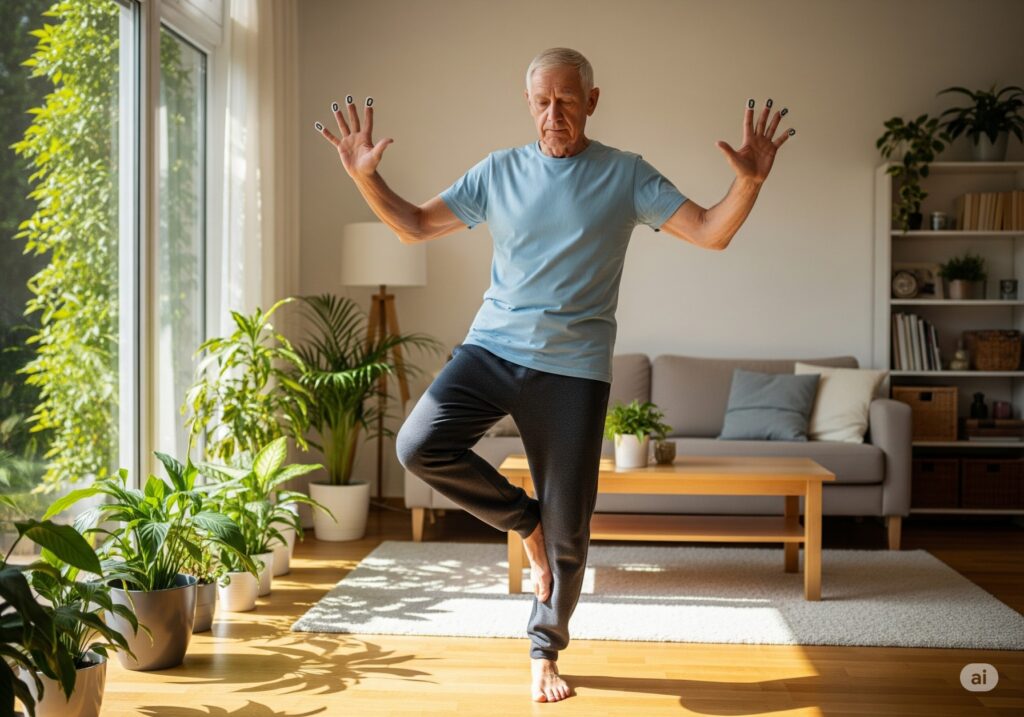
Woman doing dual task exercise for memory outdoors
Doctors say dual-task exercise for memory can boost recall and may lower dementia risk. Learn what it is, why it works, and how to start—safely.
Dual-task exercise for memory cuts dementia risk
Staying sharp is a common goal. Yet many people wonder where to start. Good news: doctors now spotlight dual-task exercise for memory as a simple, powerful tool. It pairs movement with a mental challenge. Think walking while talking. Or marching in place while counting backward. Small shifts, big gains. And importantly, research suggests it may reduce dementia risk as well. The Times of India
What is a dual-task exercise for memory?

In short, dual-tasking means you move your body and work your brain at the same time. For example, you can stroll and list capital cities. Or you can climb stairs and recite a grocery list. Even better, you can vary the tasks each week. Because variety keeps the brain engaged. Doctors interviewed in recent coverage describe this approach as a standout choice for brain health. It is practical. It is scalable. And it is doable at any age. The Times of India
Why does dual-task exercise for memory work?
First, movement boosts blood flow to the brain. That supports the delivery of oxygen and nutrients. Next, the cognitive load forces your brain to coordinate more networks at once. This raises the “challenge bar.” Over time, that can enhance attention, executive function, and recall. Harvard Health explains that exercise also helps indirectly. It improves sleep and mood and lowers stress. Those changes support better thinking day to day. Harvard Health
But there’s more. Reviews in medical journals report benefits from both aerobic and resistance work. A 2024–25 set of analyses suggests resistance training often provides strong cognitive gains—especially when paired with other modes. That is exactly what dual-tasking encourages: mixing movement types with mental work. Frontiers, PMC
The dementia link: what the research shows
There is no cure for Alzheimer’s disease. However, lifestyle changes can lower risk. The Alzheimer’s Society notes that people who exercise regularly may be up to 20% less likely to develop dementia than those who do not. Meanwhile, fresh evidence from Johns Hopkins indicates that even small amounts of weekly activity are associated with meaningful reductions in dementia risk. This is encouraging. It means you can start small and still benefit. Alzheimer’s Society, Johns Hopkins Public Health
Recent reporting underscores the dual-task angle. Doctors highlight activities like walking while conversing for memory gains, balance, and attention. Reviews in older adults with cognitive decline show that two to five sessions per week of combined movement-plus-mental tasks can improve memory and thinking skills. Some studies even report shifts in biomarkers associated with Alzheimer’s pathology. While research is ongoing, the trend is consistent and hopeful. The Times of India
How does dual-task exercise for memory look in real life

You don’t need a gym. You just need intent. Try these formats at home, in a park, or at the office:
- Walk + words: Walk 10 minutes. Name animals from A to Z.
- Stairs + subtraction: Climb stairs for 5 minutes. Count backward by 7s.
- March + memory: March in place. Hear a five-item list. Repeat it.
- Balance + brain: Stand on one foot. Spell a friend’s name backward. Then switch sides.
- Dance + directions: Follow a simple dance routine. Call out “left” or “right” before each turn.
Short, sharp drills work best. Rotate tasks often. Keep them playful. And rest when needed.
How much, how often?
Start with 10–15 minutes, 3 days per week. Then build to 150 minutes weekly of moderate activity. That target aligns with public-health guidance and many cognition studies. Yet remember: benefits can begin below that bar. For older adults, even 35 minutes per week has been linked to sizable risk reductions in some analyses. Consistency beats perfection. Johns Hopkins Public Health
What counts as “moderate”?
If you can talk but not sing, you’re likely in the moderate zone. Brisk walking, easy cycling, light dancing, or water aerobics all fit. Add the mental layer—lists, math, memory games—and you’ve created dual-task exercise for memory.
Make it progressive (and fun)
Progression keeps your brain adapting. Try this four-week template.
Week 1: Build the base
- 3×/week brisk walks, 12–15 minutes.
- While walking, name foods by color.
- Finish with 30 seconds balance per leg. Count backward from 50.
Week 2: Add complexity
- 4×/week walks, 15–18 minutes.
- During minutes 3–12, alternate tasks: odd minutes = capitals; even minutes = animals.
- After walking, sit-to-stands for 2 sets of 10 reps. Say the months in reverse order.
Week 3: Layer resistance
- 2× brisk walks, 18–20 minutes.
- 2× simple strength circuits (chair squats, wall push-ups, hip hinges).
- During sets, remember a 6-item list. Recite it between exercises.
Week 4: Mix and match
- 2× walk-and-talk sessions with a friend.
- 1× beginner dance video (learn a short routine).
- 1× park steps: up-down for 10 minutes. Count backward by 3s from 200.
Why include strength? Meta-analyses suggest resistance training meaningfully supports cognition, especially when combined with other modes. That’s dual-tasking’s sweet spot. Frontiers, PMC
Safety first: how to start smart
- Check with your clinician if you have heart, balance, or neurological issues.
- Warm up for 3–5 minutes. End with an easy cooldown.
- Scale the brain task to your comfort. If you feel overwhelmed, simplify.
- Use support (handrail, chair, partner) during balance drills.
- Stop if symptomatic: chest pain, dizziness, or unusual shortness of breath.
For general guidance on how exercise supports thinking and mood—beyond memory—see this overview from Harvard Health. It explains how better sleep, lower stress, and brighter mood all feed a healthier brain. Harvard Health
Evidence at a glance
- Doctors spotlight dual-tasking (e.g., walking while talking) as a practical way to boost memory and attention, with additional benefits for balance and mobility. The Times of India
- Regular activity reduces risk: Large umbrella summaries suggest exercisers may be up to 20% less likely to develop dementia. Alzheimer’s Society
- Small doses still help: Johns Hopkins analysts report that even brief bouts of moderate-to-vigorous activity are tied to lower dementia risk over time. Johns Hopkins Public Health
- Mode matters: Network meta-analyses point to resistance and multi-component programs as especially effective for cognition—precisely the blend encouraged by dual-tasking. Frontiers
FAQs
Is dual-task exercise for memory better than puzzles alone?
They complement each other. Puzzles are fine. But movement changes brain blood flow and chemistry in ways that seated tasks cannot. Combining both gives you more levers to pull. Reviews highlight stronger effects when different modes are merged. Frontiers
Do I need 10,000 steps?
Not necessarily. Health gains appear at lower step counts, and benefits can plateau. Aim for consistency first. Then nudge the target up if you enjoy it. What matters most is moving—and mental engagement—a habit you keep. Marie Claire UK
What if I have mild cognitive impairment (MCI)?
Gentle, supervised exercise that blends aerobic, balance, and strength work—plus mental tasks—shows promise for MCI. Start low. Progress slow. And involve a clinician or physiotherapist if possible. Frontiers, ScienceDirect
Can dual-tasking help with balance?
Yes. Because your brain must allocate attention while you move, it trains coordination and stability. Start near a rail or sturdy chair. Over time, reduce support as safe. The Times of India
Ready-to-use dual-task ideas (bookmark this)
- Coffee walk chat: Walk with a friend and trade favorite childhood memories.
- Name-that-tune steps: Climb two flights while humming and naming the artist.
- Traffic-light game: On green lights, list fruits; on red, list cities.
- Kitchen circuit: During meal prep, alternate heel-to-toe walks with reciting the recipe steps.
- Phone-free path: On a park loop, memorize five new tree or bird names, then recall them at home.
How to track progress
Keep it simple. Use a notebook or an app. Log minutes moved, tasks attempted, and what felt easy or hard. Each week, add a minute or make the mental task slightly tougher. If you miss a day, skip guilt. Just restart tomorrow.
What to pair with a dual-task exercise for memory
Lifestyle works best as a bundle. Alongside your sessions:
- Sleep 7–8 hours most nights.
- Manage blood pressure and blood sugar.
- Stay social—conversation itself is a cognitive workout.
- Eat a Mediterranean-style pattern rich in plants, fish, nuts, and olive oil.
- Protect hearing; treat depression and anxiety; stop smoking. These modifiable risks loom large in dementia research. The Times of India
Key sources and further reading
- Times of India coverage on the one exercise doctors are recommending now—dual-tasking (includes examples and research notes).
https://timesofindia.indiatimes.com/life-style/health-fitness/health-news/one-exercise-could-boost-memory-and-reduce-dementia-risk-says-doctor/articleshow/123302302.cms The Times of India - Alzheimer’s Society explainer on physical activity and dementia risk (up to 20% lower risk among regular exercisers).
https://www.alzheimers.org.uk/about-dementia/managing-the-risk-of-dementia/reduce-your-risk-of-dementia/physical-activity Alzheimer’s Society - Johns Hopkins Bloomberg School’s summary on how small doses of activity are linked with big reductions in dementia risk.
https://publichealth.jhu.edu/2025/small-amounts-of-moderate-to-vigorous-physical-activity-are-associated-with-big-reductions-in-dementia-risk Johns Hopkins Public Health - Harvard Health review: how exercise boosts memory and thinking directly and indirectly (sleep, mood, stress).
https://www.health.harvard.edu/mind-and-mood/exercise-can-boost-your-memory-and-thinking-skills Harvard Health - Network/meta-analyses on optimal exercise modes for cognition, showing strong effects for resistance and multicomponent programs.
https://www.frontiersin.org/journals/psychiatry/articles/10.3389/fpsyt.2024.1436499/full and
https://pmc.ncbi.nlm.nih.gov/articles/PMC11143595/ Frontiers, PMC
Bottom line
Dual-task exercise for memory is smart, simple, and science-supported. It blends movement with mental effort. It can start small. It scales with your fitness. And it may reduce dementia risk when practiced regularly and paired with healthy habits. So, lace up. Pick a brain game. Then move—and think—your way to a sharper tomorrow. The Times of India, Alzheimer’s Society, Johns Hopkins Public Health
Medical Disclaimer
This article is for informational purposes only and is not a substitute for professional medical advice, diagnosis, or treatment. Always seek the guidance of your physician or other qualified healthcare provider before starting any new exercise program, especially if you have an existing medical condition, balance issues, or concerns about your memory and cognitive health. Never ignore professional medical advice or delay seeking it because of something you have read here.
Call to Action
Your brain health matters—start today! Begin with a few minutes of dual-task exercise, keep it fun, and make it part of your weekly routine. Share this guide with friends or family who want to stay sharp, and let’s move and think our way toward a healthier, more vibrant future





